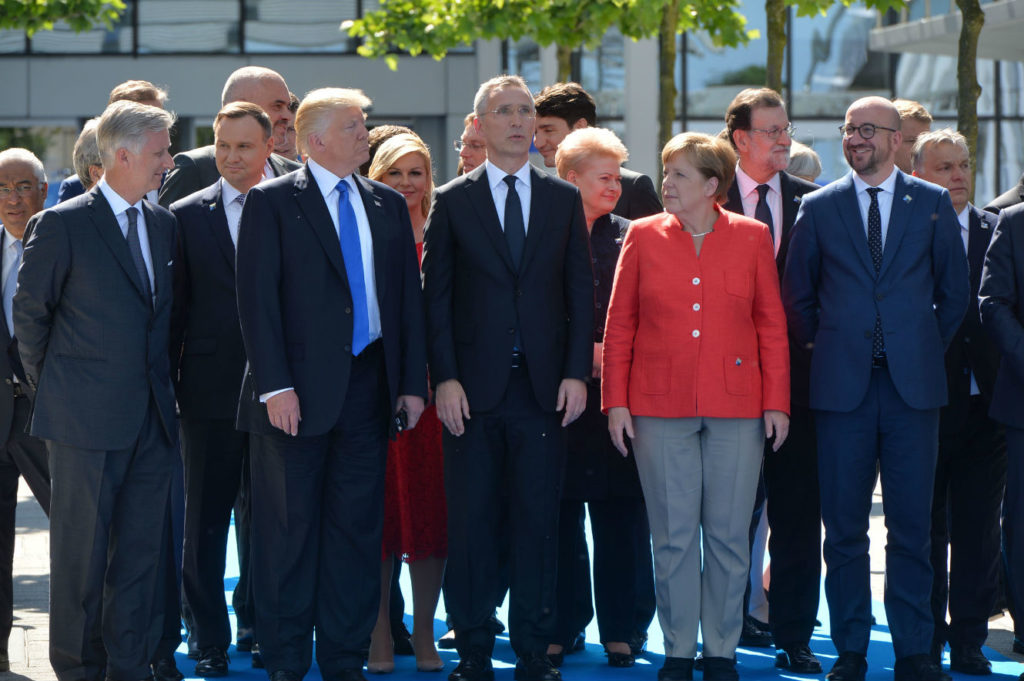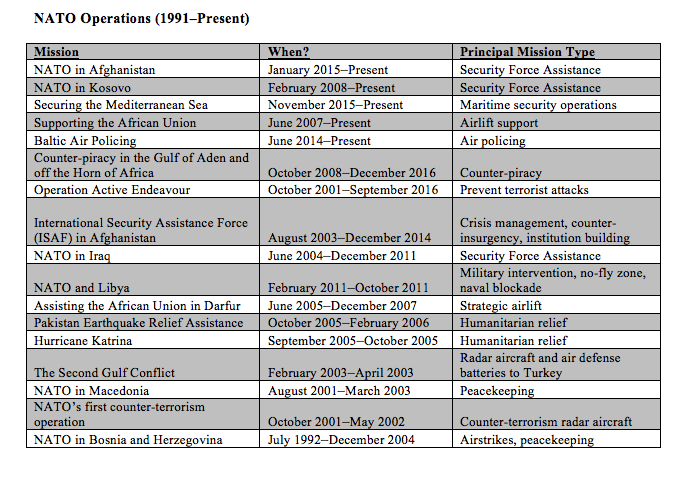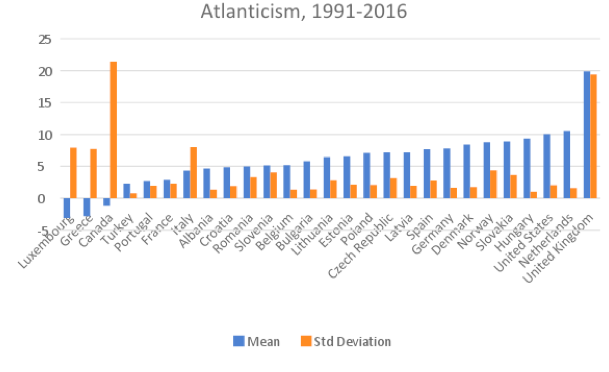What Makes a Reliable Ally? A Fresh Perspective on NATO, Strategic Culture and Collective Defense

“There is only one thing worse than fighting with allies, and that is fighting without them.”
–Winston Churchill
What is the value of an alliance? Early remarks by senior Trump administration officials led analysts to question the administration’s continued commitment to an alliance-based international order. However, the new National Security Strategy clarifies the administration’s views on allies and alliances — particularly NATO. It states that the alliance “is one of our great advantages over our competitors, and the United States remains committed to Article V of the Washington Treaty.” In fact, Emma Ashford and Joshua Shifrinson argue that the administration’s views on alliances resemble those of previous administrations and that Trump’s liberal internationalist critics are getting almost everything they could want in this strategy.
The NATO-specific language in the National Security Strategy indicates an acknowledgement that — despite the administration’s focus on allies not contributing their fair share — the alliance represents more than a simple transactional relationship. This will seem intuitively true to many, but how does one actually measure the value of an alliance like NATO? To be valuable, alliances must be credible and reliable. While the credibility is aspirational and inherently difficult to measure, my research seeks to demonstrate previously underappreciated empirical ways to capture reliability. Specifically, an alliance’s value depends on its members’ collective propensity to reliably provide collective goods. In NATO’s case, these collective goods are the alliance’s three core tasks — collective defense, crisis management, and cooperative security.
The alliance is an especially useful case study for measuring the reliability of individual members, since NATO operates by a consensus-based decision-making process, meaning that all allies must support an operation politically before an operation can be declared. Meanwhile, the alliance’s “costs fall where they lie” participation philosophy holds that individual allies bear the price of deploying and maintaining military assets to support the operation. This combination provides an opportunity to measure the reliability of individual allies based on the consistency with which they provide military assets to achieve collectively desired political ends.
My research explores the correlation between “Atlanticism” — support for a close relationship between Europe and the United States, often manifested as the preference for the United States to have a central role in European security — and participation in alliance operations. I find that a state’s Atlanticism is a statistically significant predictor of participation in alliance operations — that is, of reliability. In fact, for each additional point of Atlanticism contained in an ally’s national security strategy, an ally is on average about 7 percent more likely to participate in a declared alliance operation. My research also shows that some allies — like the Danes, Norwegians, and Italians — have their allies’ proverbial back despite not spending 2 percent of GDP on defense. Meanwhile, other allies may spend 2 percent on defense but do not reliably participate in alliance operations.
My findings add to a growing body of literature that seeks to measure burden-sharing behavior more precisely than just the share of GDP devoted to defense. Understanding the relationship between a country’s strategic culture — in particular, its support for the transatlantic relationship — and its reliability may help alliance policymakers more efficiently design future collective operations. My findings also highlight that allies are not created equally, either in terms of their strategic culture or of their demonstrated reliability over time, a fact with which the current and future U.S. administrations will continue to grapple.
Beyond the 2 Percent Pledge
Since its creation, NATO has been plagued by the challenge of sharing the costs of collective defense. The essence of the challenge is that national legislative bodies, such as the U.S. Congress, determine each country’s defense outlays. These entities are not beholden to alliance defense capability priorities and planning that are determined at the supranational level. This fundamental tension has led to frustration across American administrations, ranging from President John F. Kennedy’s remarks that “we cannot continue to pay for the military protection of Europe while the NATO states are not paying their fair share and living off the ‘fat of the land’” to President Barack Obama’s comments that “Free riders aggravate me.” The Obama administration achieved an important policy victory at the Wales Summit in 2014. Every NATO head of state pledged to move toward spending 2 percent of national gross domestic product (GDP) on defense within a decade of the Wales Summit. This development suggests that state-level elites perceive that the benefits of maintaining an adequate military capability outweigh the political and financial costs of spending more on defense— in other words, to acceptably share this burden in the eyes of its allies.
But critics contend that defense spending is an imprecise proxy for burden sharing. A central criticism of the 2 percent rule is that it focuses too narrowly on costs, and does not account for risk sharing. Others highlight that certain allies spend well below 2 percent on defense but still provide critical capabilities to alliance operations. Still other research shows that while overall defense spending positively correlates with deployability and sustainability, allies’ within-budget defense spending varies in meaningful ways. Critics offer a broad range of solutions to the imprecision of the 2 percent pledge, ranging from expanding the way defense spending is measured, to an alliance activity index, to an alliance contribution rating.
Measuring an Ally’s Reliability
Reliability — specifically, the decision to participate in operations — is an important proxy that adds nuance to alliance burden-sharing debates beyond the 2 percent pledge. Peter Cimbala and Stephen Forster define burden sharing as the distribution of costs and risks among members of a group in the process of accomplishing a common goal. Measures of defense spending relative to GDP may account for the costs side, but a composite burden-sharing gauge should also capture the risks that allies incur. I measure reliability by examining individual countries’ participation in operations abroad, from the ongoing efforts in Afghanistan, to counter-piracy activities in Africa, to more incident-specific operations like assistance after Hurricane Katrina.
NATO’s website lists eighteen ongoing or terminated alliance operations since 1991. Each of these operations is unique in its purpose, location, and duration (see table). While all allies provide consent before the alliance declares an operation, it is atypical for all allies to participate with military resources in the conduct of the operation. It can be challenging to determine which allies participated in each operation for a variety of reasons. Many alliance operations are politically controversial, and often smaller allies prefer not to state whether they participate in an operation publicly. Further, the NATO website typically cites aggregate contributions of members but rarely releases individual state contributions. Lastly, I exclude routine alliance exercises, which are planned at least 270 days in advance, because these activities do not carry substantial risk. A detailed explanation of how I quantify reliability can be found here.

Why Atlanticism?
Organizational and institutional theorists have long argued that strategic culture matters in predicting a state’s foreign policy decisions. Strategic culture is “a number of shared beliefs, norms and ideas within a given society that generate specific expectations about the respective community’s preferences and actions in security and defence policy.” Differing strategic cultures have existed in European states for centuries. For instance, Britain’s comparatively stronger national identity, unique geographic position, and colonial legacy combined to give it a strategic culture built on naval supremacy, which was fundamentally different from the one that younger, continentally-focused Germany developed. In turn, variation in strategic culture manifests itself in the way that national security apparatus’ understand and fight wars. Change is possible either from new experiences caused by exogenous shocks or from an evolution in the internal understandings of past experiences, so while strategic culture is stable, it is not fixed. Scholars typically contrast two competing dimensions of strategic cultures in the West since the end of World War II: Atlanticism versus Europeanism. The former views the United States with a central role in European security, while the latter sees Europeans as primarily responsible for European security, with the United States in a secondary role at most.
An inability to quantify strategic culture has previously limited its use by NATO researchers. However, important new research by Jordan Becker and Eddy Malesky uses the Automated Content Analysis software Wordscores to quantify the strategic culture of each ally through the language used in its national security strategy documents. The software essentially identifies phrases like “transatlantic relationship” and associates them with Atlanticism while couplets like “European autonomy” are scored as Europeanist (Becker and Malesky’s International Studies Quarterly article offers a more detailed explanation). They find that Atlanticism positively correlates with an ally’s Operations and Maintenance (O&M) share of its defense budget. This is significant because O&M budgets typically fund mission readiness and support the critical functions of deployability and sustainability. Becker and Malesky score 89 alliance national strategic documents produced between 1994 and 2012. Each ally’s strategic culture varies with time and is captured with each subsequent revision of a national security document (see chart).

In descending order, the most Atlanticist allies are the United Kingdom, the Netherlands, the United States, Hungary, Slovakia, and Norway. These six countries participated in 13 of the 18 alliance operations on average. Conversely, the six most Europeanist countries (Luxembourg, Greece, Canada, Portugal, Turkey, and France) participated in only 8 of the 18 alliance operations on average.
Becker and Malesky’s work demonstrates that these states have a greater aggregate O&M share within their defense budgets than other allies. But while their research treats O&M spending as an output, I focus on which states actually participate in alliance operations. In other words, does defense spending actually translate into taking risk on behalf of the alliance? I build on Becker and Malesky’s work by exploring whether an Atlanticist dimension of strategic culture also correlates with the decision to commit their resources to NATO operations.
In addition to Atlanticism, I also introduce two other potential independent variables that have previously been advanced as explanations for states’ foreign policy decisions — GDP per capita and geography). I apply the natural log to those two variables to account for extreme outlying observations. I also apply appropriate statistical methods to account for each mission’s context-dependency. A more detailed account of my statistical methods can be found here.
In my models, an ally’s Atlanticism has a statistically significant association with militarily participating in alliance operations. No other explanatory variables included in the models predict whether an ally decides to participate in an alliance operation. Atlanticism is a very powerful predictor of an ally’s propensity to militarily support a NATO operation.
Conclusion
The new National Security Strategy indicates that the Trump administration values NATO despite initial indications to the contrary. But the complaints about burden sharing that senior administration officials have raised are consistent with past frustrations voiced by every other administration throughout the alliance’s history. It remains important to consider what it means for an ally to contribute to collective defense. Moreover, as European security analysts debate greater autonomy for the continent, it’s relevant to look at how individual states’ dedication to the transatlantic relationship may be affecting their strategic decisions.
While Article 5’s collective defense clause affords the same security to each ally, the burden of supporting alliance operations has not been equally shared to date. Atlanticism does not just predict O&M budgets, as Becker and Malesky’s research has shown; it predicts which allies will ultimately participate in alliance operations. My findings can be used to help project participation in future alliance operations. For instance, Canada was a staunch alliance supporter of Operation Enduring Freedom, providing some of the largest percentages of ground troops to the NATO mission. However, Canada’s 2012 defense policy included language that, according to Wordscores, was significantly less Atlanticist than previous Canadian security documents, portending the possibility that Canada might prove a less reliable ally in future operations. In fact, Canada is now one of just two allies that do not contribute ground troops to Operation Resolute Support, the current NATO mission in Afghanistan that began in 2015.
Fortunately for Churchill, the United Kingdom grappled at the time with intra-alliance politics, not the challenge of going it alone. Even so, while declared alliance operations require political unanimity,subsequent widespread military participation among allies is not guaranteed. My findings indicate that not only are some allies more likely to participate in operations than others, but that a dimension of strategic culture — Atlanticism — is in fact a strong predictor of reliable participation. Future alliance planners would do well to not only analyze which allies historically participate in operations at the highest rates, but also how key language in recent allied national security strategic documents has changed. In doing so, they will reduce the likelihood of realizing Churchill’s nightmare.
Bryan Frizzelle is a Ph.D. student at the University of Texas in Austin. He is a Lieutenant Colonel in the United States Army with recent operational experience planning and participating in NATO training exercises in central and eastern Europe. The views expressed in this article are the author’s own and not the views of the United States Army or Department of Defense.
Image: NATO/Flickr

